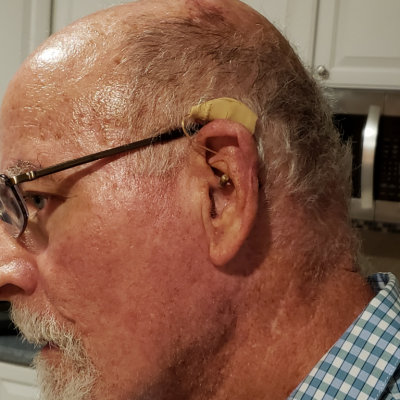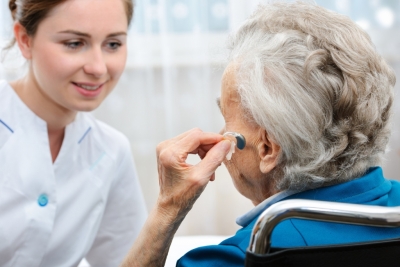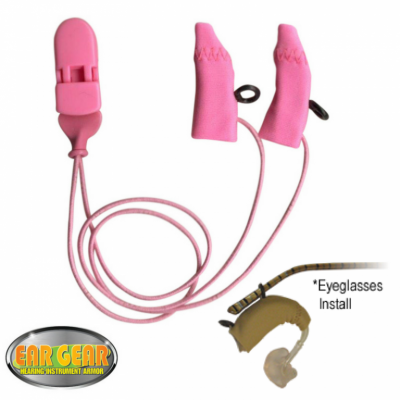We all know how safety and comfort features make a home feel like a haven. For the millions of Americans who report trouble with hearing, home enhancements and updates that increase comfort, safety, and convenience aren’t just “cozy” ideas. They’re essential for enjoying a satisfying and independent life at home.
The great thing about modern home design tips for people with hearing loss is that they can be implemented at any time. It’s not too late to get a “custom” home just because a home is already built. It’s helpful to know about features that enhance quality of life for people who are hard of hearing when taking on a home remodeling project that will close gaps that are leading to struggles and frustrations.
It can also be helpful to have a list of must-have features when shopping for a new home. In fact, certain features should be on the radars of people who are hard of hearing, parents of children who are hard of hearing, children helping their parents with hearing loss, family members of veterans dealing with hearing loss, and anyone else involved in a situation where home life can be enhanced by hearing-focused features. It’s amazing how much quality of life can improve when a home feels more accessible for people with hearing loss. With the help of experts in the field, this article will discuss design elements and technology upgrades that make life at home better for those who are hard of hearing:
- Dr. Catherine Fabian, Assistant Clinical Professor for the Doctor of Audiology program at Northwestern University.
- Dr. Laura Coco, Clinical Audiologist and Assistant Professor at San Diego State University.
Design Elements To Consider When Creating an Accessible Home
“More modern homes seem to be built for style and not for function as it relates to communication. Newer homes might be beautiful to look at, with stained concrete floors, walls of windows, and high ceilings, but these features pose challenges for communication even for people with no hearing loss,” says Dr. Coco. However, there are some changes people can make to acommodate for those with hearing loss and make it safer to navigate.

Hearing aids, cochlear implants, or bone-anchored hearing aids help, but improving acoustics, reducing noise sources, and obtaining line of sight between communication partners, even while wearing hearing devices will significantly reduce listening effort and minimize mis-hearing or misunderstandings.
— Dr. Catherine Fabian, Assistant Clinical Professor for the Doctor of Audiology program at Northwestern University.
1. Wider Hallways
Tight hallways can be tough for people who are hard of hearing. While many American homes are built with narrow hallways designed for single-file walking, having the ability to walk side by side while communicating is essential for someone who relies on lip reading or ASL. Wide, short, and curved hallways can all be great options for maintaining eye contact. As Cleveland Clinic points out, facial expressions and body language add vital information to the message being conveyed during interactions with individuals who are hard of hearing.
2. Open Floor Plan
An open floor plan can be a breath of fresh air compared to blocked-off rooms because this setup allows for larger sight lines. “Think about where conversation typically occurs and what activities are typical. We all hear better when we can see our partner talking,” says Dr. Fabian. Clear, unobstructed views make speaking across a room much easier. Openness can be especially important in the space that links the kitchen with the main living area because this is where most household conversations occur.
“If chatting while making dinner, a kitchen layout that allows the someone to see their family member across an island while cooking or washing dishes establishes the ability to use speech-reading cues for ease of understanding,” says Dr. Fabian.
Another tip is to use rounded walls and corners instead of right angles to avoid “cutting off” one room from another when building or reconstructing a home.
3. Acoustics
Acoustics in a home can dramatically impact the quality of life for someone with hearing loss. It’s not necessarily about just allowing sound to “travel better” in a home. The wrong acoustics can actually cause painful, distracting echoes and vibrations that can degrade hearing.

Avoid or reduce reflective surfaces, such as tile, concrete, and uncovered windows, and add more more absorptive objects and surfaces, such as carpet and heavy drapes. Opt for lower ceilings as opposed to high or vaulted ceilings.
— Dr. Laura Coco, Clinical Audiologist and Assistant Professor at San Diego State University.
Here’s a rundown of the core acoustic points to hit in a home:
Ideally, a home designed to accommodate the needs of someone who is hard of hearing would have high-end double-pane or triple-pane windows that insulate the interior against sounds. Someone looking for a budget fix can consider weatherstripping, caulking, or adding heavy drapes to repel road noise and outside sounds. “Broad window vistas bounce sound creating reverberations and echoes that make it difficult to understand conversation,” says Dr. Fabian.
Lower ceilings help to cut out distracting and disorienting echoes. In a home with higher ceilings, acoustic tiles can prevent sound from bouncing around. Another “cheap fix” for high ceilings is to use lots of plush materials on the floor, walls, windows, and furniture to stifle echoing.
There are two ways to look at flooring when designing a home for people who are hard of hearing. First, some people actually like “hard” floor surfaces because they can be used as communication tools. Tapping a foot or cane against a tile floor can be great for getting someone’s attention. However, others prefer to cut down on echoing by selecting carpets, vinyl flooring, or softwood.
4. Lighting
The right lighting can enhance visual acuity for people relying on lip reading and ASL to communicate. The goal is to create even, balanced lighting throughout the home that allows facial features and expressions to be easily read. Lighting should be consistent from room to room. In addition, it’s important to balance sunlight and shadows to ensure that a home maintains consistent lighting at all times of the day and night. In high-sunshine rooms, shades and curtains are essential for diffusing direct sunlight that can obscure features, expressions, and movements. Generally, recessed lighting can be a good option for creating shadow-free lighting.
Don’t stop at indoor lighting. Outdoor motion-sensor lighting is essential for creating good visibility when entering and exiting the home. Audit walkways, driveways, patios, and other spots for visibility to determine the best spots for motion-based lighting. Sensor lights can also deter intruders.
5. Color Schemes
A home’s palette can increase ease and comfort for someone who has hearing loss. Cool, calm colors that don’t cause distractions with conflicting patterns and designs are preferred. One tip for making a home an ASL-friendly home is to contrast paint and fabric tones with skin color to help define signing. Avoiding high-reflectivity colors and sheens is also smart. The “no” list includes bright whites, glossy shades, and shiny finishes.
Home Safety Tips for People With Hearing Loss
People with deafness or hearing loss need to be extra aware of their surroundings, especially at home, where safety is essential. “If an individual has more than a moderate hearing loss, visual or tactile alerts should be considered if there are concerns that the usual alarms will not be sufficiently loud,” says Dr. Fabian. In this section, we will take a look at some practical and easy-to-implement safety measures and home modifications to create a safe and comfortable living space for people with hearing challenges.
Things You Should Avoid:
- Ignoring Visual Alerts: Avoid solely relying on auditory signals; integrate visual alert systems for doorbells, alarms, and other notifications.
- Neglecting Maintenance: Regularly check and maintain all assistive devices and safety equipment to ensure they function optimally when needed.
- Overlooking Lighting: Adequate and well-distributed lighting is crucial; don’t neglect areas that may require extra or specialized lighting for safety.
Safety Tips for People with Hearing Loss:
- Visual Alert Systems: Install systems that use flashing lights or vibrations to signal doorbells ringing, alarms sounding, or phones ringing.
- Vibrating Alarm Clocks: Opt for alarm clocks designed with bed shakers or vibrating pads to ensure you can start your day without a hitch.
- Smoke and Carbon Monoxide Detectors with Strobe Lights: Incorporate detectors that emit bright, flashing lights in addition to loud alarms, providing visual cues during emergencies. “Consider any safety requirement that has a signaling component such as smoke detectors or carbon monoxide detectors. Someone with hearing loss who can’t be wearing their device (e.g. sleeping at night) will need an alternative alert: visual strobe, vibration pillow or bed shake, or loud (>85 dBA) and low frequency (<= 500 Hz) audible signals,” says Dr. Fabian.
- Security Cameras with Visual Alerts: Implement security cameras linked to your smartphone or tablet, sending instant visual notifications of any activity detected.
- Captioned Phones: Utilize phones equipped with captioning services, allowing you to read conversations in real time.
- Clear Pathways: Maintain open and obstacle-free walkways, minimizing the risk of tripping or stumbling, particularly in low-light conditions.
- Smart Lighting Systems: Adopt smart lighting solutions, adjustable through mobile devices, ensuring adequate lighting levels throughout your home.
Technology Additions for Safety and Comfort
Technology has become the ultimate home accessory for those who are hard of hearing. For those who have already integrated technology into their daily lives for learning and communication purposes, implementing technology into a home’s design is a fantastic way to improve quality of life without a construction project. Here’s a look at some of the best technology upgrades to make a user-friendly home.
A smartphone-integrated living space can make life at home feel boundless for someone who has hearing loss. For millions of people with hearing loss, smartphones are already essential communication tools both inside and outside the home. Linking smartphones with compatible devices around the home creates confidence, convenience, and safety without big architectural upgrades. Currently, several hearing aids offer options to sync with in-home devices to control home settings, get alerts and notifications for events happening in a home, and call for help.
Whisper-quiet appliances can make a huge difference. Noise pollution from older, clunkier appliances can make it hard for a person with hearing loss to hear essential sounds. Upgrading to quiet appliances can help with that. In addition, newer appliances with smart-app capability for controlling and monitoring functions provide people with the ability to control their surroundings on a single screen.
It’s common for people who are hard of hearing to feel vulnerable at home because they can’t always be confident that they’ll detect signs of danger based on “telltale” sounds alone. In reality, everyone is safer when they have their homes outfitted with smart and connected security systems. A modern security system that links phones or tablets to alerts and live surveillance screens can help people with hearing loss to feel informed and prepared.
A smart doorbell is one of the most essential security features for a user-friendly home for someone who is hard of hearing. Linked with a monitoring camera, a smart doorbell provides both text and visual alerts whenever visitors arrive. Newer technology allows for certain security systems to link to smart bulbs that are programmed to flash specific colors to notify homeowners of specific situations. Bulbs might turn red for fire, blue for flood, or green for strong winds to create instant recognition when quick action is needed. Finally, it’s essential to have a non-auditory alert system in place for smoke and carbon monoxide detectors. Syncing text, strobing, or color-based alerts to a phone allows for quick, life-saving action.
The smart bed shaker is shaking up what many people thought were the limits of technology in the home. Bed shakers are capable of being fixed to any bed design and are great for emergency and everyday uses. These Wi-Fi-enabled devices produce significant shaking much stronger than a standard smartphone alert. They are great for daily wake-up alarms. Most allow for charging with a battery backup to ensure constant connectivity. The best part is that bed shaker devices are typically linked to Alexa and Google Assistant to provide constant assistance.
Additional Resources for Individuals Who Are Hard of Hearing
Navigating through life with hearing loss can be challenging, but various organizations offer invaluable support, resources, and assistance:
- National Association of the Deaf (NAD): NAD extends a wide range of resources for individuals with deafness or hearing loss, as well as their families and friends. For further support, you can reach out via email through the contact form on their official website.
- Hike Fund, Inc.: Supporting children from birth to age 20, Hike Fund, Inc. offers hearing aids and assistive devices to low-income kids, making crucial hearing support accessible to all.
- National Disability Institute: Providing financial resources and support, the National Disability Institute offers a variety of services, including American Sign Language videos and other supportive resources for the Deaf and Hard-of-Hearing community.
- National Council on Aging (NCOA): The NCOA provides vital resources for seniors, with crucial information and assistance options for obtaining hearing aids, including community-specific resources and discount programs.
- Alexander Graham Bell Association for the Deaf, Inc.: They offer financial grants for the rehabilitation, education, and enrichment of deaf and hard-of-hearing children. The AG Bell Association can be contacted via Voice/TTY: 202-337-5220, TTY: 202-337-5221, or Fax: 202-337-8314, and Email: info@agbell.org.
- Let Them Hear Foundation: Established in 2003, the Let Them Hear Foundation provides vital services to patients worldwide through their Cochlear Implant and Pediatric Hearing Aid Program.
- Help America Hear Program: This program offers new, high-quality hearing aids to individuals with limited financial resources nationwide. They ask that applicants explore all other financial resources before applying to ensure that those most in need receive assistance.
- Easter Seals Hearing Aids and Audiology Services: Easter Seals gives access to hearing aids and audiology services for those experiencing hearing impairment or loss, with services available for both adults and children.
- Travelers Protective Association Scholarship Trust for the Deaf and Near-Deaf (TPA): Established by the Travelers Protective Association of America, this trust offers financial aid to those who are deaf or hard of hearing, providing assistance for obtaining devices, treatments, and specialized education, among other services.
Each organization listed offers unique support and resources tailored to the needs of individuals with hearing loss, providing a network of support and assistance for those navigating life with hearing challenges.
Final Thoughts
Living with hearing loss requires resilience and proactive adjustments to your surroundings. With the many resources, organizations, and technologies available, people with hearing impairments can lead independent and fulfilling lives. Staying informed, utilizing support systems, and making thoughtful home modifications are essential steps to creating a supportive and accessible living environment. These resources and tips are designed to empower and support you so that your journey through hearing loss can be one of confidence and community support.
Our Experts
Dr. Catherine Fabian, AuD provides assessment and rehabilitation for adults and children of various disorders of the auditory system including hearing loss, tinnitus, noise exposure, and auditory processing disorders. She teaches academic and clinical courses in Northwestern University’s Doctor of Audiology program.
Dr. Laura Coco, PhD, AuD is a clinical audiologist and an Assistant Professor at San Diego State University. Dr. Coco’s research focuses on identifying disparities in the delivery of hearing healthcare services and developing strategies to improve access to, and equity of, audiology care for marginalized populations.

Scott Westerlund, Contributor





